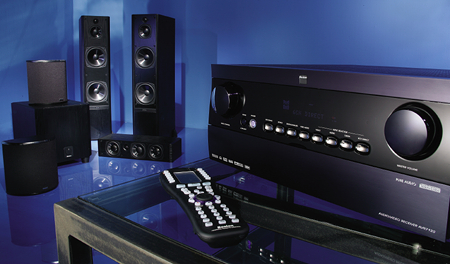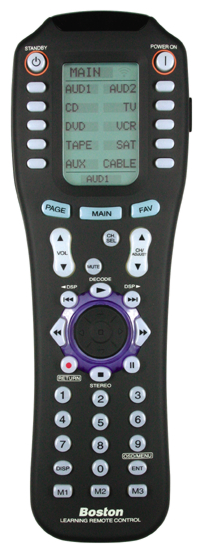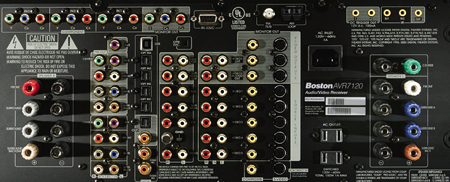Boston Acoustics AVR7120 A/V Receiver and VR3 Speaker System -
Steve Guttenberg, July, 2005
Big ambitions.
Boston Acoustics has been perfecting the art of speaker design for 26 years, so I guess they're ready to try something new. For 2005, the company set their sights on the fiercely competitive A/V-receiver market and released a classically handsome, custom-installer-savvy contender, the AVR7120. To keep it all in the family, I checked out the receiver with a contingent of Boston VR Series speakers.
Heavy Metal Thunder
Boston's first-ever receiver comes with an enviable set of features. The AVR7120 ($2,999) transcodes all video sources, so even your crusty old VCR can be routed through your TV's component connections. Every permutation of Dolby and DTS is available, including Dolby Headphone, which delivers a credible surround experience with stereo headphones. The AVR7120's bass management covers every format and input, and that's a plus because it vastly simplifies setup. It would have been even nicer if Boston allowed you to defeat the bass management to avoid its analog-to-digital conversion on selected sources. For example, if you paid big bucks for a high-end SACD/DVD-Audio universal player, you probably wouldn't want its already-decoded-to-analog signals to be redigitized. On the upside, analog devotees haven't been forgotten: The AVR7120's jack-packed hindquarters sport a phono input.

This seven-channel receiver will happily run two pairs of side surround speakers and rear surrounds at the same time. Hmm, that's one, two—up to six surround speakers. Add in the three front channels, and the AVR7120 can drive up to nine speakers on seven channels at once. Yes, the receiver is amply endowed, but you can get all of that good stuff without dropping three grand on a receiver. So, inquiring home theater shoppers want to know—what's so special about the AVR7120?
Just two things: superior sound and build quality. Its substantial weight, 51.8 pounds, was my first glimmer of the receiver's high-end aspirations—and a bit of poking around under the lid revealed that most of that heft can be attributed to the AVR7120's large transformer, massive heat sinks, and potent power supply. I'm not just referring to mine-is-bigger-than-yours bragging rights, either. The heavy stuff is largely responsible for the AVR7120's see-through transparency and sonic gravitas. Then again, Boston Acoustics' step-down receiver, the $2,199 AVR7100, makes due with a little less power and a slightly smaller connectivity suite, but it might get within shooting distance of the AVR7120's superior sonics. Big spenders might want to move up to Boston Acoustics' spiffy new AVP7 pre/pro and A7200 seven-channel power amp. Each is priced at $1,999.
The AVR7120's fully backlit LCD remote handles macros and is custom-install-friendly—although someone may have to plow through its separate 60-page owner's manual to get the job done. A smaller second-zone remote is also included with the receiver.
Speaking of Speakers
The VR3 is the flagship model in the company's VR Series. It's a full-sized tower, all right, but, since the VR3 is much deeper than it is wide, it doesn't seem as big as it really is. The speaker's gracefully curved front baffle and grille add a distinctive flair to its look. Hiding behind the grille, you'll find Boston's very best tweeter. This 1-inch aluminum dome features a special heat sink on its rear to improve power handling; up front, there's an amplitude-modification device (AMD) that looks like a tiny carrying handle. Look at the AMD sideways, and you'll spot a series of tiny holes tuned to tame the dome's ultra-high-frequency peak. The AMD produces a smoother treble response and protects the tweeter from inquisitive fingers.
Next, the engineers squeezed the tweeter close to the 4-inch midrange driver to improve the VR3's imaging focus and off-axis response. It's also worth noting that the tweeter and midrange are positioned near the top of the tower, so they'll be closer to the height of a center speaker living on top of a TV. That'll ensure a more stable soundstage across the front three speakers, while a pair of 7-inch woofers supply low-end muscle. The VR3s have dual sets of all-metal binding posts and sound a little better biwired; the other speakers use plastic connectors and are single-wired only. If the engineers' goal for the VR3 was to cram a bunch of top-of-the-line features into an affordable three-way tower design, I think they've nailed it.
Before I popped off the slimline VRC center speaker's grille, I assumed it was a run-of-the-mill, woofer/tweeter/woofer design, but it is in fact a bona fide three-way center. To achieve the VRC's low-profile shape, Boston's clever engineers placed the 1-inch dome tweeter to the side of the 4.5-inch midrange driver. (Most three-way centers are bigger and bulkier because the tweeters are positioned over their midrange drivers.) The side-by-side arrangement is a neat solution, and, while the VRC's midrange driver is based on the same driver as the 4.5-inch woofers, they are different designs. This gambit worked for me—the VRC's lateral dispersion is excellent. When I moved way over on the right side of the couch, I still heard natural-sounding dialogue from the VRC.
The VRX surround speaker defies easy categorization as a dipole or bipole design. This half-round, asymmetrical speaker features active and passive woofers, with front- and rear-firing tweeters. In other words, the VRX's fore and aft response is intentionally different—aim its active woofer toward the listening position, and you'll get a more localizable sound. The passive side produces a more diffuse sound. To experiment, just swap the left and right VRXs, and see which sound you prefer. I went for the more direct sound. The speaker is available in a black or cherry finish, but, if you've got to have white surrounds, check out Boston's white bookshelf models that can be used as surround speakers, or go for a pair of their white quarter-round Bravo II surrounds. They're designed for corner placement.
 While the speakers are all designed in-house, they're built offshore, so I was surprised to learn that the 12-inch PV900 subwoofer is made in Boston's Peabody, Massachusetts, factory. We all know that subwoofer power ratings can be a little, er, optimistic, but the Boston boomer's 300 watts are backed up with genuine FTC certification, so it's an honest-to-goodness 300 watts. The amp is also the beneficiary of Boston's self-monitoring, self-correcting BassTrac circuit that keeps the lid on distortion at thundering high-output levels. The PV900's front-mounted volume control makes for easy bass-level tweaking. As 12-inch subs go, the PV900 is a little fella, and I was afraid it wouldn't be up to the job of augmenting the big towers' bass grunt, but it's a brute. The PV900 goes plenty low for my tastes. While the speakers are all designed in-house, they're built offshore, so I was surprised to learn that the 12-inch PV900 subwoofer is made in Boston's Peabody, Massachusetts, factory. We all know that subwoofer power ratings can be a little, er, optimistic, but the Boston boomer's 300 watts are backed up with genuine FTC certification, so it's an honest-to-goodness 300 watts. The amp is also the beneficiary of Boston's self-monitoring, self-correcting BassTrac circuit that keeps the lid on distortion at thundering high-output levels. The PV900's front-mounted volume control makes for easy bass-level tweaking. As 12-inch subs go, the PV900 is a little fella, and I was afraid it wouldn't be up to the job of augmenting the big towers' bass grunt, but it's a brute. The PV900 goes plenty low for my tastes.
Ready, Set, Go
When I put the AVR7120's auto-setup system through its paces, it unleashed a series of whooshes and beeps to get a fix on the intricacies of my room's acoustics and interactions with the VR speakers. So far, so good. But, when I checked the accuracy of the calibration, I discovered that the AVR7120 jacked up the subwoofer level beyond the bounds of good taste and mistakenly deemed the VRC center speaker as large. Sorry, but I beg to differ. I prefer to run centers with 4.5-inch woofers as small speakers, so I had to go in and make those corrections manually. More gripes: The AVR7120's owner's manual leaves out way too much information and is a bit of an organizational mess. It took me a while to muddle through and learn enough to make everything work. The receiver's onscreen displays and remote menu navigation are trickier than they ought to be. But, with the setup rigors out of the way, it was time to have some fun.
The system never hesitated to rock, groove, swing, thrash, and shout when I played the Bad Plus' stunning new CD, Blunt Object: Live in Tokyo (Columbia). When the guys play piano, bass, and drums with the anarchic energy of the Who, which they do a lot, the Bostons positively roared. On Stravinsky's The Soldier's Tale multichannel SACD (PentaTone Classics), the sound had remarkable depth and beautiful tonality. The resolution of fine spatial detail on David Crosby and Graham Nash's Another Stoney Evening DVD-Audio (Arista) took my breath away. The VRX surrounds seamlessly meshed with the front three VR speakers. A series of vivid jazz duets with saxophonist Archie Shepp and bassist Neils Pedersen showcased the VR3s' ability to shade these masters' most subtle inflections and nuanced moves—the two musicians took up virtual residence between the speakers. The Boston receiver and speakers are unrepentantly natural sounding, with no added warmth or bloom. Or so I thought.
To confirm that hunch, I first swapped the AVR7120 out of the system to get a handle on its sound and later jockeyed other brands of speakers into position with the AVR7120. The exercise proved that Boston's speakers sound great with other receivers, and the AVR7120 knocked my socks off when I mated it with my reference Dynaudio Contour speakers, but I'm a glutton for transparency. That said, at the end of the day, the all-Boston sound came away with top honors.
The system's bass is also a thing of wonder: It's deep, tight, and plays loud enough to fill even a fairly large home theater with soul-stirring subterranean sounds. You know that lowdown, funky intro to Stevie Wonder's "Boogie on Reggae Woman"? Well, you've got to hear it through a set of VR3 towers. I felt those rolling bass lines through my feet. Stress-testing the PV900 sub's seismic fortitude with the Pirates of the Caribbean DVD was a blast—those cannonballs smashing into the ships sounded appropriately fierce. And the fantasized midair collision on the Fight Club DVD dislodged the wall clock in my kitchen, and it crashed to the floor.
I have to admit that, at first, I didn't really understand why Boston Acoustics would dare to go up against the established electronics manufacturers. Now that I've lived with the complete system, I just wonder why it took them so long to branch out. Not that the AVR7120 won't sound great with other brands' speakers, but there's no denying the Boston-on-Boston synergy. The same is true with the VR Series speakers: Boston must have been doing something right over the past quarter of a century designing speakers that sing with everybody else's electronics. Let the good times roll!
Features

Processing Modes: Dolby: Digital 5.1, EX, Pro Logic IIx, Headphone, Virtual Speaker
DTS: DTS, ES, 96/24, Neo:6
THX Certification: No
Audio D/A Converter: 24-bit/192-kilohertz
Number of Amp Channels: 7
Power Rating (per channel): 120 watts, into 8 ohms
Frequency Response: 10 Hz–100 kHz
Dimensions (H x W x D, inches): 7.75 x 17.3 x 17.75
Weight (pounds): 51.8
Price: $2,999
These listings are based on the manufacturer's stated specs; the HT Labs box below indicates the gear's performance on our test bench.
Connections
Inputs:
Video: component video (3), S-video (7), composite video (7)
Audio: coaxial digital (2), optical digital (5), 7.1-channel analog (1), stereo analog (3), phono (1)
Outputs:
Video: component video (1), S-video (3), composite video (3)
Audio: coaxial digital (1), optical digital (1), stereo analog (3), 7.1 preamp (1), sub woofer output (2)
Additional:
RS-232 (1), USB audio input (1), 12 volt trigger outputs (2), infrared jacks inputs/outputs (2/1)
Ratings: Boston Acoustics AVR7120 A/V Receiver
Build Quality: 94
• Lift it up, and you'll learn a lot about the AVR7120's build quality
• Looks and feels like a high-end component
Value: 90
• Yes, it's expensive, but it sounds really expensive
• Boston's AVR7100 receiver is a tempting, less pricey alternative
Features: 92
• Adjustable A/V synchronization maintains lip sync for all sources and displays
• Upgradeable flash memory
Performance: 94
• Gets awfully close to separates levels of sound quality
• Dolby Headphone processor is a big plus for headphone users
Ergonomics: 75
• Poorly written owner's manual frustrates setup chores
• Onscreen menu navigation could be better
Overall Rating: 91
Boston hit one out of the park with their first-ever receiver. The AVR7120 sounds stellar and is eminently capable of serving in even the most complex custom-installation systems. |
